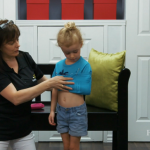

- 16 March 2020
- |
- Andrée Bouchard
You give the child an instruction, but he doesn’t follow it. Why is this? Is he distracted, or is he acting deliberately to transgress the instruction? Before concluding that the child is acting out of opposition or ill-will, we need to ask ourselves whether the way we give instructions might not be to blame…
3 tips to ensure our instructions are well received :
- Keep instructions short. A child who receives an instruction that is too long or contains many elements may only be able to do part of it. Instead of: “Give me your drawing, put your crayons away and go get your coat”, we could ask him to give us his drawing and put his crayons away, and then, when he’s completed the first instruction, ask him to go and get his coat.
- Make eye contact with the child and speak directly to him when you give an instruction. If the educator says, “It’s time to put the toys away”, the child may not feel concerned if he or she hasn’t been specifically addressed, especially if there’s a lot of noise around.
- Have the child repeat the instructions to make sure you’ve understood them correctly. The child can repeat in his own words what he has to do, allowing the educator to verify what has been understood. Avoid asking the question “Have you understood?” to which the child might answer “yes” because he doesn’t realize he doesn’t understand, or because he doesn’t want to have to repeat the instruction.
In the training document “From A to Z… 26 intervention techniques”, you’ll find observation strategies and solutions to make our interventions with children more effective.
Appeal to the child’s dominant mode of communication
Each of us uses our five senses to appreciate and understand the world around us. However, people usually communicate by focusing on one of their five senses.
40% are visual
40% are auditory
20% are kinesthetic
Kinesthetes are people who communicate more through the sense of touch. Kinesthetes codify mental representations in the form of sensations and emotions. In general, all young children are kinesthetic. However, auditory and visual preferences soon emerge.
It is possible to get your message across to the child more effectively by respecting his or her dominant mode of communication. The educator can limit repetition and obtain the child’s cooperation more easily by adopting a better way of communicating.
The visual child…
Is curious and alert. He’ll do anything to attract your attention so that you’ll look at him. Visual children need precise explanations, if possible accompanied by visual support (pictures or demonstrations).
The auditory child…
Calm and often a good sleeper. They like to talk, ask questions and tell you all sorts of things, which means you have to listen. When forbidden something, auditory children need logical explanations. The most effective disciplinary techniques with auditory children involve hearing, such as compliments and changes of tone.
The kinesthetic child…
Enjoys bathing and cuddling. He often says “Let me do it” or “I can do it! He needs to experiment on his own, and even detailed explanations won’t be enough. Touching his shoulder and catching his eye when you give an instruction will ensure that the message is received. The most effective disciplinary techniques with him will involve his participation and physical contact.
Examples of intervention:
Children who have difficulty coping with separation from their parent :
- For the visual child, we suggest that parents leave a photo of themselves or family members for the child to look at when bored. You can also install visual markers on the walls so that the child can “see” the passage of time (such as a routine caterpillar or a clock).
- For the auditory child, we can ask the parent to tell us the child’s favorite song so we can sing it to him, or lend us his favorite bedside book to tell the story at naptime. We can also talk to him about his parents and explain what they’re doing while he’s at daycare.
- For kinesthetic children, you can leave a transitional object that they can touch, squeeze or smell (a scarf impregnated with their mother’s perfume, for example) when they feel the need.
Children who have difficulty following instructions:
- We address the visual child by looking him in the eye and using words that appeal to his way of communicating and by supporting with a visual aid: “Look carefully at what we’re going to do”, “Do you see what I mean?”, “Come and put on your beautiful blue coat!”.
- We address the auditory child by appealing to his preference for sounds (appropriate tone of voice, making sure that ambient noise does not prevent him from understanding the instruction) and by giving explanations that he will be able to understand: “Listen carefully to what I’m going to tell you”, “Did you hear what I asked you?”.
- We address the kinesthetic child by appealing to his feelings, his sensations: “Close the door, you’ll be cold”, “Do you feel like doing this activity?”, “Come on, let’s put on your soft sweater!”
Is your child’s behavior confusing you, or are you having trouble getting him to follow simple instructions? We can provide you with professional references:
- La Ligne-Parents: http://ligneparents.com/coordonnees/
- Éducation-coup-de-fil: http://www.premiereressource.com/
- Ordre des Psychoéducateurs et Psychoéducatrices du Québec: http://www.ordrepsed.qc.ca/
- Ordre des Psychologues du Québec: https://www.ordrepsy.qc.ca/




